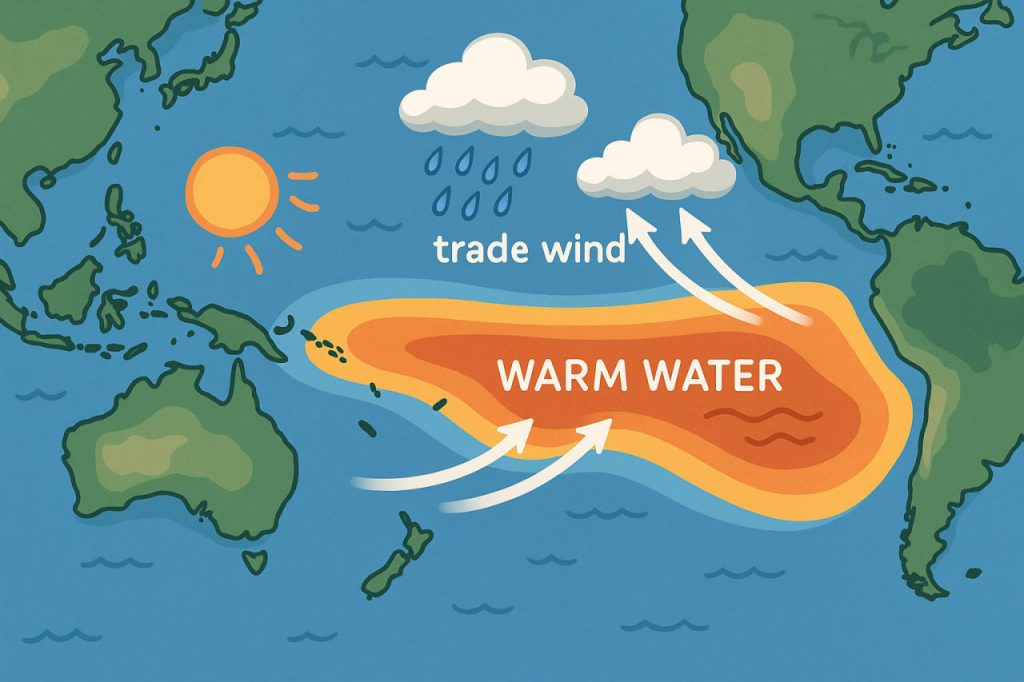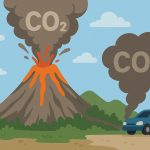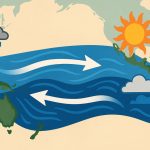El Niño is a powerful and irregular climate pattern that affects weather systems across the globe. It originates in the tropical Pacific Ocean, but its effects ripple through many regions, altering temperatures, precipitation, and even the frequency of extreme events like droughts, floods, and hurricanes. Understanding El Niño is essential for predicting seasonal weather changes and preparing for climate-related impacts.
How El Niño Forms
El Niño is one phase of a larger climate system known as the El Niño–Southern Oscillation (ENSO). Normally, trade winds blow from east to west across the tropical Pacific, pushing warm water toward Indonesia and Australia while allowing cooler water to upwell near the west coast of South America.
During an El Niño event, these trade winds weaken or even reverse, allowing warm surface water to accumulate in the central and eastern Pacific. This disrupts the normal temperature balance of the ocean and alters global atmospheric circulation.
Effects on Weather Around the World
The arrival of El Niño can shift rainfall patterns, raise sea surface temperatures, and influence the jet stream—a fast-flowing air current in the upper atmosphere. These changes can trigger severe weather anomalies in many regions.
For example, South America may experience floods, while Southeast Asia and Australia suffer droughts. In the United States, El Niño often brings wetter winters to the southern states and warmer, drier conditions to the north. Africa and India may also face serious disruptions in monsoon rainfall and food production.
El Niño vs. La Niña
El Niño is the warm phase of the ENSO cycle. Its counterpart, La Niña, is the cool phase, during which trade winds strengthen and push warm water further west than usual. This results in cooler-than-average temperatures in the central and eastern Pacific and a different set of global weather effects.
While both El Niño and La Niña influence global climate, their patterns often alternate every 2 to 7 years, though the intensity and duration of each event can vary widely.
Impact on the Environment and Economy
El Niño events can have devastating consequences. In agriculture, changing rainfall and temperature patterns may cause crop failures, livestock deaths, and food shortages. Fisheries along the coast of South America may collapse due to reduced nutrient upwelling, affecting marine life and coastal economies.
Increased wildfire risks, coral bleaching, and the spread of diseases like malaria and cholera are also associated with El Niño. Economically, the damages can reach billions of dollars globally, particularly in vulnerable countries.
How Scientists Monitor and Predict El Niño
Scientists use a combination of ocean buoys, satellite data, and climate models to monitor sea surface temperatures, wind patterns, and ocean currents. Early warning systems can detect the development of El Niño months in advance, helping governments and industries prepare.
Forecasting El Niño remains complex because it involves interactions between ocean and atmosphere on vast scales. However, predictive skill has improved significantly in recent decades thanks to global monitoring networks and computational modeling.
Conclusion
El Niño is a naturally occurring ocean-atmosphere phenomenon with global reach. While it begins in the Pacific Ocean, its consequences can be felt on nearly every continent. From altered rainfall to economic losses and environmental stress, El Niño reminds us of the interconnectedness of Earth’s climate systems. Improved forecasting and international cooperation are key to minimizing its impacts.
Glossary
- El Niño — a periodic warming of sea surface temperatures in the central and eastern tropical Pacific, disrupting global weather.
- Trade winds — steady east-to-west winds that blow across the equatorial Pacific Ocean.
- ENSO (El Niño–Southern Oscillation) — a climate cycle that includes both El Niño and La Niña phases.
- Upwelling — the rising of nutrient-rich cold water from deep in the ocean to the surface.
- Jet stream — a high-speed band of winds in the upper atmosphere that influences weather patterns.
- La Niña — the cool phase of ENSO, opposite of El Niño, characterized by stronger trade winds and colder sea temperatures.
- Climate models — computer simulations used to predict atmospheric and oceanic behavior.
- Coral bleaching — the whitening of corals due to stress from high water temperatures or other environmental changes.


